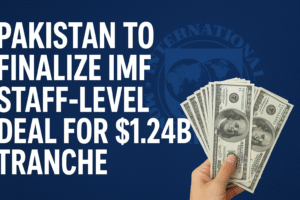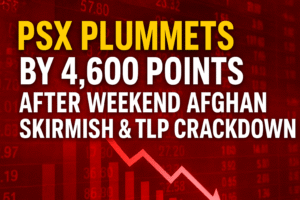PSX Plummets by 4,600 Points After Weekend Afghan Skirmish & TLP Crackdown
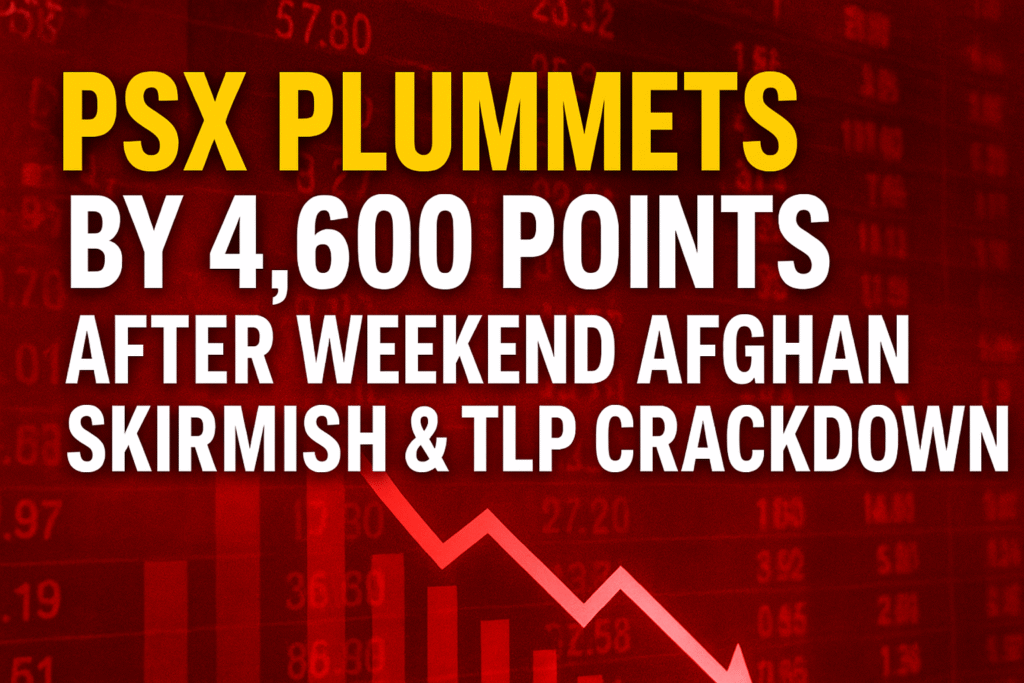
Introduction
Pakistan’s financial markets began the week under intense pressure as the Pakistan Stock Exchange (PSX) witnessed one of its sharpest single-day declines in recent months. The KSE-100 Index tumbled over 4,600 points on Monday, wiping billions of rupees in market capitalization within hours of trading.
The crash followed two simultaneous shocks over the weekend:
-
A deadly border skirmish between Pakistan and Afghanistan, and
-
A forceful government crackdown on Tehreek-i-Labbaik Pakistan (TLP) protesters.
These developments rattled investor confidence, deepened uncertainty, and amplified fears of wider political and geopolitical instability. Analysts described the decline as a reflection of “panic selling amid compounding fears,” while traders called it “a perfect storm of politics, security, and sentiment.”
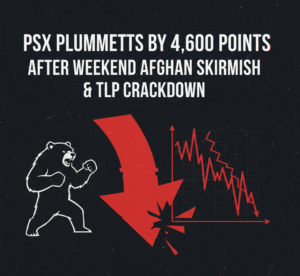
Background: Fragile Stability Meets Sudden Shock
Before Monday’s meltdown, Pakistan’s equity market was already struggling with multiple headwinds. Inflation remained stubbornly high, the rupee faced downward pressure, and negotiations with the International Monetary Fund (IMF) had not produced the clarity investors were hoping for. PSX plummets 4600 points, Pakistan stock market crash, TLP crackdown, Afghan border clashes, KSE-100 decline, Pakistan economy.
The KSE-100 Index had already lost nearly 3.5% in the previous week, reflecting caution about economic direction. With valuations stretched and sentiment weakening, any adverse news was likely to trigger a correction.
The weekend’s twin crises provided precisely that trigger — but on a scale few anticipated.
The Weekend That Shook Investor Confidence
1. The Afghan Border Clash
Late on Saturday night, intense fighting erupted along the Pakistan-Afghanistan border. Both sides traded heavy fire, resulting in significant casualties.
By Sunday morning, local media were reporting the deaths of several Pakistani soldiers. Military officials confirmed a large-scale cross-border attack by armed groups operating from Afghan territory, prompting Pakistan to respond with “retaliatory precision strikes.”
Unofficial reports suggested heavy losses on both sides, though figures varied widely. The escalation disrupted border trade and led to the temporary closure of key crossings, straining already tense bilateral relations.
This development sent shockwaves through the business community. Traders feared further deterioration in cross-border commerce, regional security, and diplomatic ties — all crucial factors for investor sentiment.
2. TLP Crackdown Sparks Political Anxiety
Simultaneously, tensions rose inside Pakistan as the Tehreek-i-Labbaik Pakistan (TLP) resumed nationwide protests under its “Labbaik Ya Aqsa” campaign. Demonstrations were triggered by anger over government policies and alleged silence on international issues.
Over the weekend, TLP workers gathered in large numbers near Muridke, attempting to march toward Islamabad. Authorities blocked roads and deployed riot police to contain the movement. Clashes broke out when protesters defied security cordons.
By early Monday morning, reports of a full-scale crackdown surfaced — with arrests, injuries, and reports of casualties. Major highways were blocked, mobile internet service was partially suspended in Lahore, Gujranwala, and parts of Rawalpindi.
The combination of domestic unrest and border insecurity over just 48 hours fueled panic among investors when markets opened.
Market Reaction: Massive Sell-Off
When trading began on Monday, investors immediately rushed to offload positions. Within the first hour, the KSE-100 Index had already shed over 3,000 points, forcing brokers to trigger circuit breakers.
By closing, the index had dropped 4,654 points (−2.85%), settling near 158,443.
Out of nearly 480 active scrips, fewer than 80 gained, while over 370 declined. Market capitalization shrank by hundreds of billions of rupees in a single session.
Traders described the day as “panic-driven,” with institutional investors joining retail sellers in trimming exposure. The sudden withdrawal of liquidity caused widespread declines across virtually every sector.
Major Sectors Hit Hard
Banking Sector
Banks bore the brunt of the sell-off. Shares of Habib Bank, MCB Bank, and United Bank Limited fell sharply as investors priced in potential pressure on profitability.
Higher political risk typically leads to higher borrowing costs and reduced lending activity. Market participants also expressed concerns about deposit flight and tightening liquidity if tensions escalate.
Industrial & Fertilizer Stocks
Blue-chip names such as Engro Corporation, Engro Fertilizers, and Lucky Cement saw heavy selling. Investors fear possible disruptions in trade routes and logistics chains due to unrest in Punjab and Khyber Pakhtunkhwa.
Energy companies also faced losses amid expectations of slower industrial activity and reduced demand in the near term.
Insurance & Financial Services
Insurance companies experienced a net sell-off of nearly USD 25 million, according to brokerage estimates. Increased volatility and uncertainty tend to reduce new policy sales and increase risk exposure for insurers, prompting sharp revaluations of their equity holdings.
Technology Sector
Technology firms such as Systems Limited saw notable declines. Analysts said that although the IT sector remains fundamentally strong, fears of capital outflows and a weaker rupee weighed on valuations.
Why Investors Reacted So Sharply
Several overlapping factors intensified the market’s reaction:
-
Geopolitical Shock: The border clash reignited fears of sustained regional instability — a persistent overhang for Pakistan’s economy.
-
Political Uncertainty: Crackdown on TLP revived memories of past unrest that disrupted supply chains and paralyzed cities.
-
Economic Fragility: Investors already doubted Pakistan’s fiscal resilience; the new turmoil confirmed their fears.
-
Panic & Herd Behavior: In thinly traded markets, selling can become self-reinforcing as margin calls and stop-loss orders trigger cascades.
Analysts’ Views: “A Storm of Uncertainty”
Market analysts and economists described Monday’s crash as a textbook example of compounded risk.
Yousuf M. Farooq, Research Director at a Karachi brokerage, said the drop was “expected given the scale of weekend events.” He noted that the market “reacted to both domestic and cross-border developments simultaneously — a rare and highly volatile combination.”
Analysts agreed that the correction reflected fear, not fundamentals, and that long-term investors should wait for clarity rather than sell in panic. Still, most expect volatility to persist unless the government successfully de-escalates both crises.
The Broader Economic Context
Inflation & Monetary Tightness
Pakistan is currently battling double-digit inflation. High food and energy prices, combined with currency depreciation, have eroded purchasing power. The central bank has maintained a tight monetary stance, with policy rates at historic highs.
These conditions restrict liquidity in the market, making equity investments less attractive in the short term.Currency Pressure
The rupee’s weakness against the U.S. dollar continues to haunt investors. Any further slide could erode corporate earnings and increase the burden of external debt repayments.
Currency volatility also discourages foreign portfolio inflows — critical for stabilizing the PSX.
IMF Program Uncertainty
Negotiations for an IMF staff-level agreement remain ongoing. Delays in securing disbursement have dented confidence in Pakistan’s reform trajectory. Investors now fear that political turmoil may further slow talks or derail commitments.
Geopolitical Fallout: Border Tensions & Diplomacy
The Afghan border clash marks the most serious escalation in months. Both governments have traded accusations of harboring militants.
For Pakistan, the security risk is twofold: potential refugee inflows and renewed militant activity along its western frontier.
Regional trade, a key pillar of Pakistan’s growth strategy, could face disruption if tensions persist. Truck convoys carrying goods between Chaman, Spin Boldak, and Torkham crossings were reportedly halted temporarily.
Diplomatically, Islamabad faces a dilemma — balancing national security concerns with the need to maintain cross-border economic ties.
Political Implications: TLP and Beyond
The TLP, known for its street mobilization strength, has once again demonstrated its ability to challenge state authority. The group’s supporters demand stronger action on international religious issues, but their marches often morph into broader anti-government demonstrations.
For the ruling coalition, this poses a difficult test: maintaining order without igniting wider unrest. The crackdown may stabilize the situation temporarily but could strain relations with religious constituencies.
Markets, however, tend to react negatively to any hint of social polarization or urban disruption — factors that reduce consumer activity and investment.
Investor Sentiment: Fear Over Fundamentals
Market behavior over the past 24 hours reflects an extreme case of sentiment-driven selling.
-
Foreign investors reportedly sold positions worth millions of dollars.
-
Mutual funds and insurance companies also reduced holdings to protect liquidity.
-
Retail investors faced margin calls, forcing them to liquidate holdings at a loss.
This pattern, according to analysts, is typical when political events overshadow fundamentals. Historically, the PSX has often rebounded after similar corrections once stability returns. PSX plummets 4600 points, Pakistan stock market crash, TLP crackdown, Afghan border clashes, KSE-100 decline, Pakistan economy.
Historical Parallels
Pakistan’s stock market has seen comparable plunges during periods of political crisis:
-
The 2014 Islamabad protests caused a similar sell-off as investors feared government instability.
-
In 2018, uncertainty during elections triggered massive volatility.
-
The 2022 TLP march disrupted trading activity for weeks.
Each time, the PSX recovered within months after clarity emerged — suggesting that while panic can be swift, confidence can return equally fast when the environment stabilizes. PSX plummets 4600 points, Pakistan stock market crash, TLP crackdown, Afghan border clashes, KSE-100 decline, Pakistan economy.
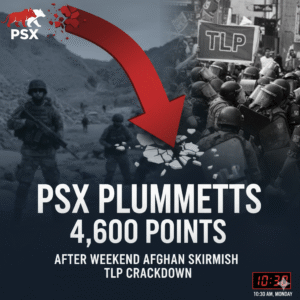
Sector-Wise Impact: Deep Dive
| Sector | Status | Drivers of Decline |
|---|---|---|
| Banking & Finance | Down 3.8% | Credit risk, higher NPL fears |
| Cement & Construction | Down 4.2% | Political unrest halts demand |
| Energy & Petroleum | Down 3.5% | Oil price swings, reduced consumption |
| Technology | Down 2.9% | Currency weakness, export uncertainty |
| Insurance | Down 4.0% | Market volatility, portfolio losses |
| Textiles & Exports | Down 3.6% | Border closures, logistic disruptions |
What Could Stabilize the Market
Experts highlight several conditions that could help restore stability:
-
Diplomatic De-escalation at the Afghan border through high-level talks.
-
Political dialogue to defuse TLP tensions.
-
Renewed IMF engagement ensuring financial stability.
-
Currency stabilization measures via central bank interventions.
-
Market communication from regulators to calm investor fears.
If these steps occur swiftly, the PSX could witness a rebound similar to prior recovery cycles.
Long-Term Outlook: Resilience Amid Volatility
Pakistan’s stock market has historically been resilient. Despite recurring shocks, it remains one of South Asia’s most dynamic exchanges.
Valuations have now fallen to attractive levels, with dividend yields rising. Some fund managers view the current dip as a buying opportunity for long-term investors with high risk tolerance. PSX plummets 4600 points, Pakistan stock market crash, TLP crackdown, Afghan border clashes, KSE-100 decline, Pakistan economy.
Still, experts caution that volatility will remain elevated until the twin crises — at home and on the border — are resolved.
Investor Guidance
For investors navigating current turbulence, the following principles may help:
-
Stay Defensive: Focus on blue-chip stocks with strong cash flows.
-
Avoid Leverage: Use conservative positions to manage risk.
-
Diversify: Balance portfolios between equities, bonds, and commodities.
-
Monitor News: Geopolitical events can alter market direction instantly.
-
Be Patient: Markets often overreact to shocks before stabilizing.
Economic Lessons & Policy Implications
This episode highlights key lessons for Pakistan’s policymakers:
-
Security & Stability are Economic Assets. Political or border unrest directly affects investor confidence.
-
Communication Matters. Clear, credible government messaging can prevent panic.
-
Diversified Economy Reduces Risk. Over-reliance on sentiment-driven sectors amplifies volatility.
-
Investor Education is Vital. Many retail investors still react emotionally to short-term headlines.
The government’s challenge is to strike a balance between maintaining order and preserving economic calm.
Future Scenarios: Best-Case vs Worst-Case
| Scenario | Outcome | Probability |
|---|---|---|
| Best-Case: Diplomatic resolution, IMF deal, and calm restored | Market rebounds, PSX recovers lost ground | 40% |
| Moderate: Protests ease but border tension lingers | Volatility persists, slow recovery | 35% |
| Worst-Case: Escalation in both crises | Sustained market losses, capital flight | 25% |
Investor Psychology: Understanding Panic
Behavioral finance teaches that markets often fall faster than they rise because fear spreads faster than optimism. Monday’s plunge was driven more by perception than actual financial deterioration.
When traders see red screens, they rush to exit positions. This leads to “cascade selling”, where losses feed further losses. Recognizing this pattern helps long-term investors avoid emotional decisions.
Global Perspective: How Pakistan Compares
Regional peers like India, Bangladesh, and Sri Lanka also face political and inflationary pressures, but Pakistan’s exposure to geopolitical conflict gives it a higher risk premium.
Foreign investors often treat the entire region as a single risk cluster, meaning that domestic unrest can push up Pakistan’s country risk even if fundamentals improve. Managing perceptions abroad is thus as important as managing policy at home.
Steps Authorities Could Take
To restore calm, experts suggest:
-
Coordinated Statements from the Finance Ministry, State Bank, and PSX reassuring investors.
-
Engagement with institutional investors to prevent panic withdrawals.
-
Temporary relief measures such as easing margin requirements or halting short selling.
-
Fast-tracking diplomatic channels with Kabul to prevent further escalation.
-
Public transparency about the security situation to curb rumors.
Confidence, once shaken, requires clear and credible action to rebuild.
Conclusion
The 4,600-point fall in the PSX is a stark reminder that Pakistan’s economy cannot remain insulated from its political and security realities. A weekend of violence and confrontation translated into billions in market losses, underlining the deep link between governance and financial confidence. PSX plummets 4600 points, Pakistan stock market crash, TLP crackdown, Afghan border clashes, KSE-100 decline, Pakistan economy.
Yet history suggests recovery is possible. Pakistan’s markets have bounced back from crises before — provided stability and communication return. PSX plummets 4600 points, Pakistan stock market crash, TLP crackdown, Afghan border clashes, KSE-100 decline, Pakistan economy.


